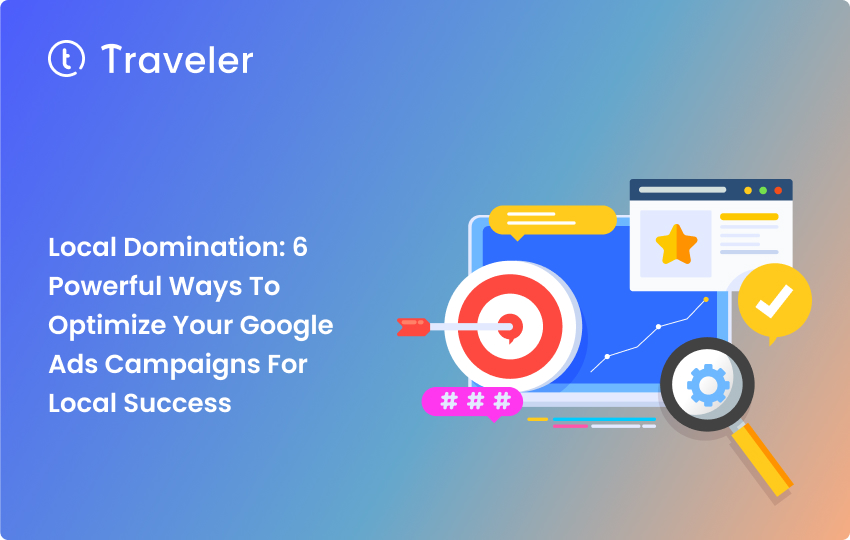
Table of Contents
It’s great to see that you’re interested in optimize google ads local campaigns for your travel business. With the rise of Google Travel, the travel industry has become even more competitive, making it more important than ever to ensure that your business stands out from the competition. By optimizing your Google Ads local campaigns, you can reach a highly targeted audience of potential customers in your local area, increase your online visibility, and drive more traffic to your website. In this discussion, we’ll explore some tips and strategies for optimizing your Google Ads local campaigns and boosting your bookings and revenue. Let’s dive in and get started!
Given the increase in domestic tourism, tour operators are starting to concentrate more on local markets, thus it is more necessary now than ever to learn how to build and optimize your Google Ads local campaigns.
Google Ads local campaigns are developed for businesses with a physical location to engage potential customers about when and how to reach their locations.
Local campaigns can be shown on Google Search, Google Maps, Gmail, Google Display, and YouTube. You may know that Google Ads may produce quick results (a massive amount of traffic or even new tourists) from the beginning, but you need to know how to drive your campaigns to success.
If you are running a travel agency, look no further! We will share with you 5 ways to optimize your Google Ads local campaigns in today’s post.
Keyword Research
Identifying relevant keywords for local campaigns
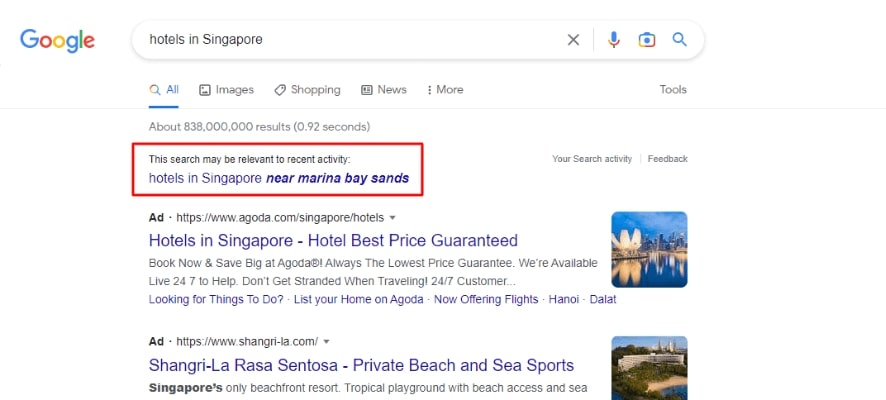
The best part of Google AdWords local campaigns is that travel agencies can target customers depending on the terms they use when searching for travel and where they are searching from. This is perfect for attracting new tourists as well as identifying relevant keywords for local markets.
So how to do so? At this point, you will need to brainstorm. For travel, think of what tourists search for:
- Locations: it can be a place name, a hotel, a bus station, etc. Here you may need some geographical words. For example, “hotels in Singapore”, “best restaurants near me”, “way to Marina Bay Sands”, etc.
- Things to do/Activities: This will be narrowed down to a certain location your travel service offers. For example, “things to do in Singapore”, “diving in Thailand”, etc.
- Prices: This is definitely what customers care about most. For example, “ hotel prices Singapore, tour Singapore-Malyasia prices”, etc.
Once you keep these concepts in mind, you’ll be able to quickly brainstorm all of your local keywords. Make a keyword list using the example above.
As image above you may find some relevant keywords (that people search for) for your local campaigns.
Using tools like Google Keyword Planner and Google Trends
Brainstorming is not just enough! Don’t hesitate to leverage tools for researching keywords for your local campaigns.
Two can’t-ignore tools (for both beginners and advanced marketers) are Google Keyword Planner and Google Trends. They are totally free.
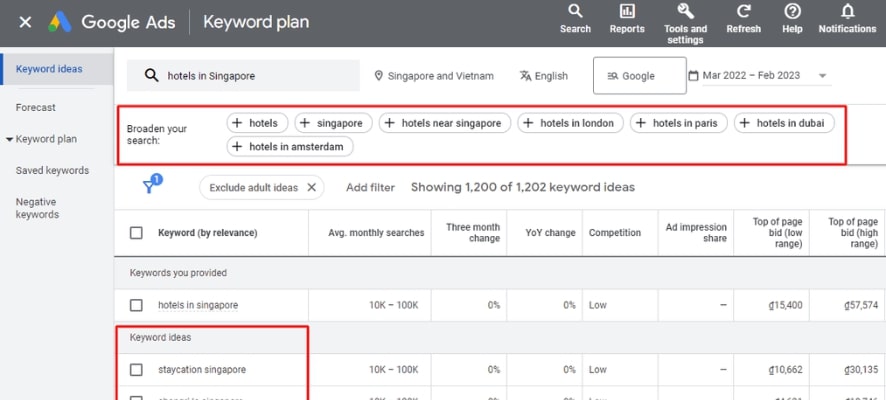
Google Keyword Planner will help you to find new keywords, estimate search volumes, and calculate the cost of targeting them. Although Google Keyword Planner is essentially a PPC (pay-per-click) advertising tool, it also works well with SEO strategies.
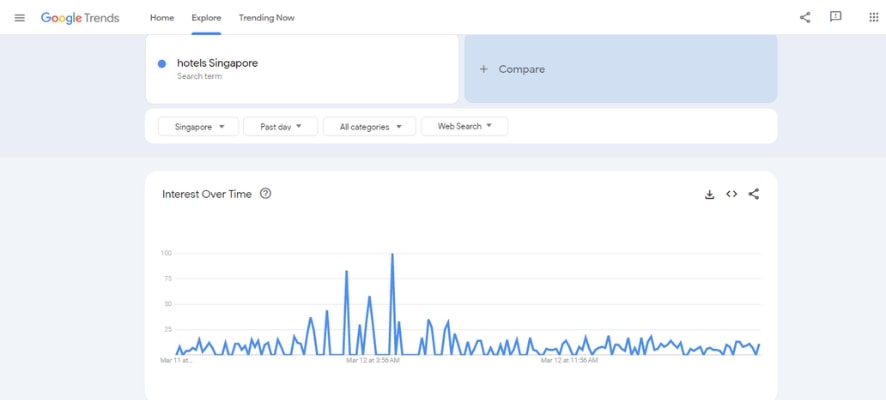
Google Trends uses real-time data to look at the popularity of search terms on Google. It provides users with what others are looking for based on the time of year, the season, and the location.
Analyzing search volumes and competition
Perhaps this part is one of the keys that determine the survival of the advertising campaign. It will take some of your time and effort.
All you need to do is extremely careful analysis. The most important metric is search volumes. Pay attention to comparing search volumes with different keywords at different times to determine which keyword group is for each time.
Don’t forget to check the competition and bid prices of those keywords over time. This will help you filter the keywords that best fit your marketing strategy and budget.
Ad Copy
Crafting ad copy for local campaigns

An effective strategy for grabbing the attention of tourists is well-written Ad copy content. The text in your search advertisements can determine whether a customer clicks or scrolls down.
Incorporating location-specific language and targeting
The increased relevance that comes with targeting a specific location is the reason why local advertising frequently outperforms global campaigns. Be sure to include location-specific language and targeting in your ad copy.
To make the most of this local relevance, use the target area’s name in your ad copy. The visitors will be aware that you are specifically aiming for their location. You may additionally incorporate a well-known building, language from the area, or other clear clues.
Your ad copy will be more effective the more local relevance you can give. For each place you wish to target, you might want to create specific ad copy.
Highlighting unique selling points and promotions
What tourists look for after determining where they go, where and what to play is typically promotions or simply looking for some unique and attractive service. Ad copy will be where tour operators show their wonderful services.
Also, you can include extra information about your promotion. In this way, you can increase exposure to your offers and promotions. According to Wordstream, implementing promotion extensions resulted in a nearly 10% boost in CTRs for their customers.
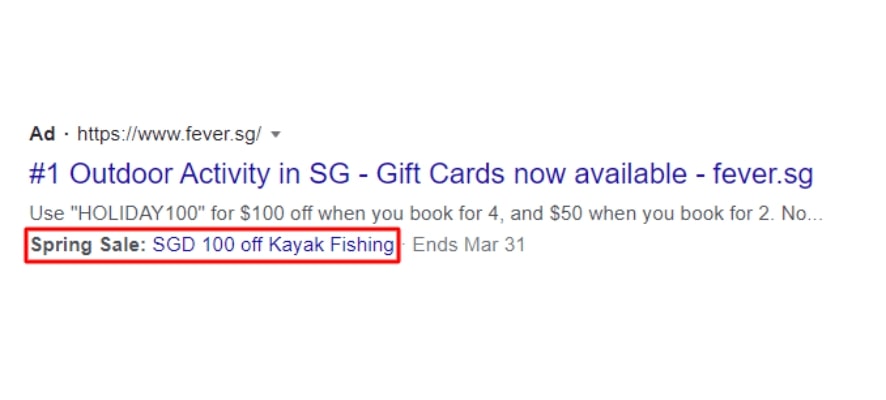
Ad Extensions
Types of ad extensions available for local campaigns
Tourists might not be interested in going to your travel pages. They could only be seeking a phone number or location to contact or visit. This is the perfect moment to encourage your local visitors to quickly communicate with your company at any time.
This information may be found in the site extensions of your local advertisements!
There are many types of ad extensions out there but for local campaigns, here are some ad extensions you can use:
- Structured snippet extensions
- Image extensions
- Call extensions
- Location extensions
- Price extensions
- Promotion extensions
- Sitelink extensions
Below we’ll talk about 2 key extensions specifically for travel service ads: location extensions and call extensions.
Implementing location extensions for a travel agency website
Implementing location extensions in your ads is an excellent way of improving their relevancy. Google will make every effort to provide local activities when someone searches for nearby things to do.
Also, employing local ads is a cheap way to boost your exposure and in-person shop visits. You can put your address on your Google Ads so that people can see where you are physically located by using the location extension.
If you’re running a travel agency website with the WordPress Traveler theme, one way to boost your business’s online visibility is by implementing location extensions for your Google Ads campaigns. By displaying your business’s location on Google Maps, you can make it easier for potential customers to find and visit your business.
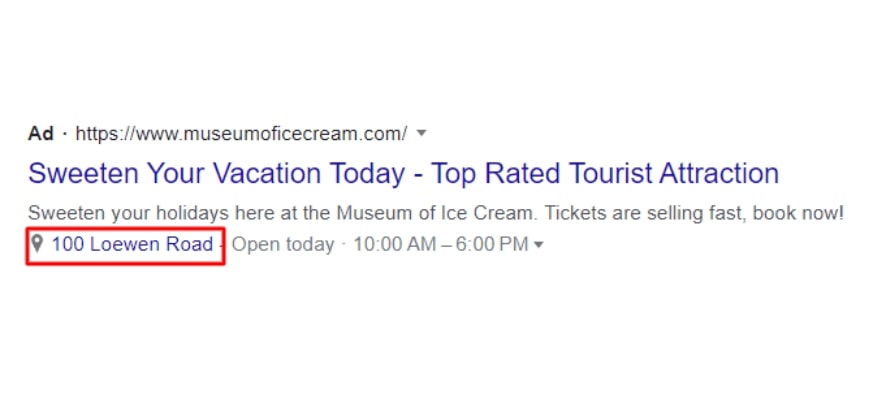
Using call extensions to drive phone calls
It’s reasonable to expect that the great majority of local businesses will want to include a phone number, especially in sponsored ads.
The call extension might also have a schedule that follows the opening hours of your company. You might decide to hide the extension during the hours when your company is closed.
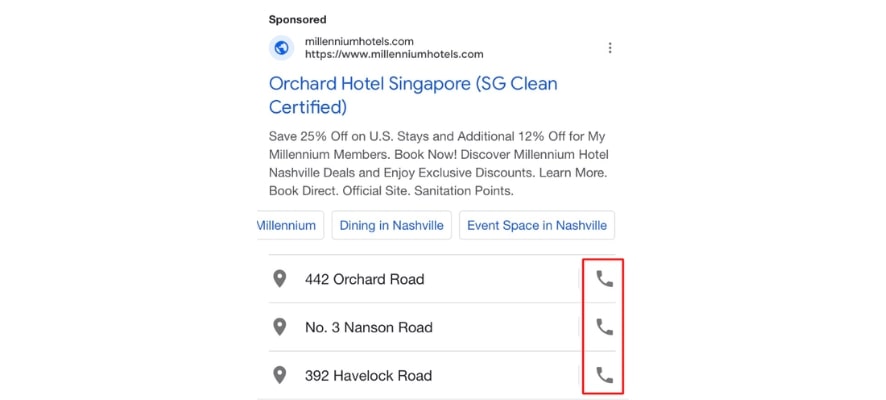
Targeting
Geographic targeting options for local campaigns
Google also gives you the option to choose the locations where your advertisements will run. If you aren’t geo-targeting your Google AdWords campaigns, you’re missing out on opportunities to bring local visitors to your website.
Based on their IP, WiFi, or GPS data, geo-targeting determines the location of your potential customer. You can now pick the users to whom your ads are displayed based on the search engine they are using.
Consider the geographic regions where your potential customers are going to be. Remember that most people will likely just take day travels or weekend trips to local destinations because of current travel trends.
Moreover, geo-targeting allows travel agencies to track tourist behaviors based on their location.
Radius targeting and location-based targeting
Choose the campaign you want to modify, then under “Targeted” you can choose the specific location you want to target or radiuses.
For example, if you believe that a local would book your beach activities in Dee Why, Sydney for a single day, you might decide to focus on an area within a 5-mile radius of Dee Why—the ideal range for one-day entertainment trips.
Moreover, distance reports allow you to keep track of how each radius performed. When customers see your advertisement, these records track how far away they were from your location or place of business.
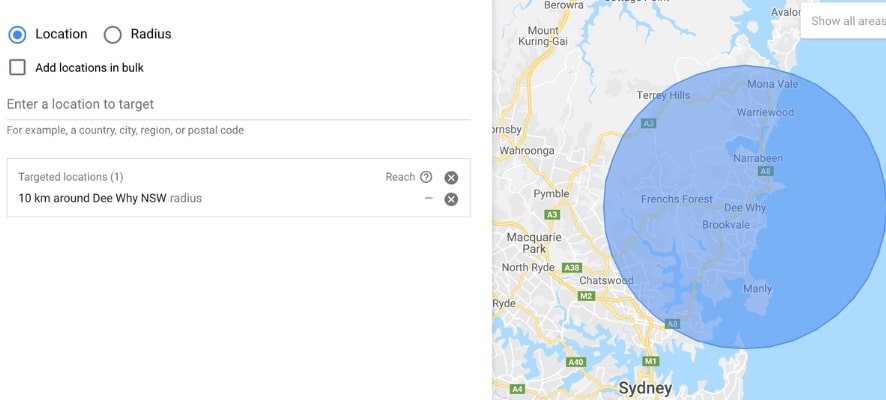
Device targeting and scheduling
Three device targeting options are available for Google Ads:
- Desktop
- Tablet
- Mobile
With the rise in smartphone and tablet usage, device targeting on Google AdWords has gotten more powerful and more crucial for marketers.
According to BIA/Kelsey study, the amount spent on location-targeted mobile advertising will increase from $12.4 billion in 2016 to $32.4 billion in 2021. Regarding ad scheduling, you can choose which weekdays and what times you want to run your advertising.
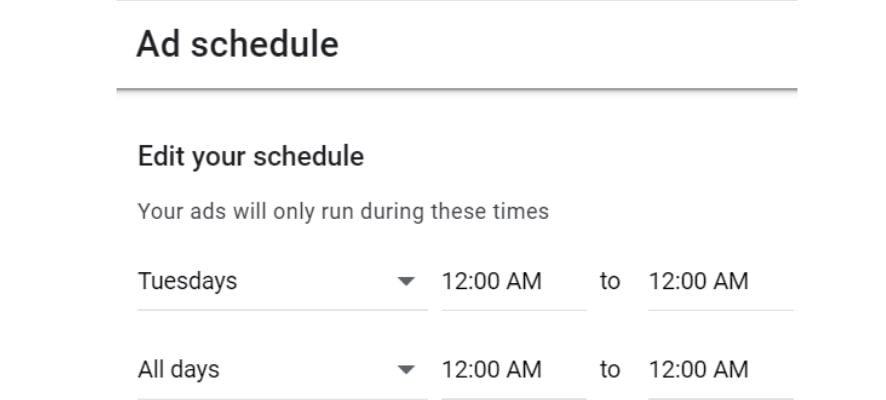
Applying it will prevent your adverts from performing poorly. During these certain hours, increase your ad budget by making bid changes.
You may run advertisements all day long with bid changes, but there will be more of them during specific times. Also, you can automate the process with the use of scripts.
Tracking and Optimization
Setting up conversion tracking for local campaigns
Every website should have conversion tracking, even if it’s just to track form submissions on the contact us page.
You should look at Google Tag Manager conversion tracking to properly benefit from the advantages of Google local ads.
The Google Tag Manager makes it simple and flexible to integrate conversion events from digital advertising campaigns.
Analyzing performance and making necessary optimizations
You can use Google Tag Manager to set Google Adwords conversion tags, which can be used to generate full reports about what occurs when a user clicks on your advertisement.
This step can involve enrolling in your newsletter, downloading a PDF file, calling your company phone number, or making a booking, depending on your website. A conversion will be recorded if one of these actions is marked as significant.
You will be able to optimize your campaign and more skillfully manage your ad budget thanks to these data.
Implementing A/B testing with different ad formats
Even if you are a Google AdWords professional, A/B testing is must-have. You should think about testing your keywords, bids, bidding tactics, audience targeting, and other things.
We highly advise investing a part of your earnings just in A/B testing. Just keep in mind to only analyze one variable for each test. Otherwise, the A/B tests won’t be able to reveal which element is impacting things.
Real Examples
Airbnb experiences
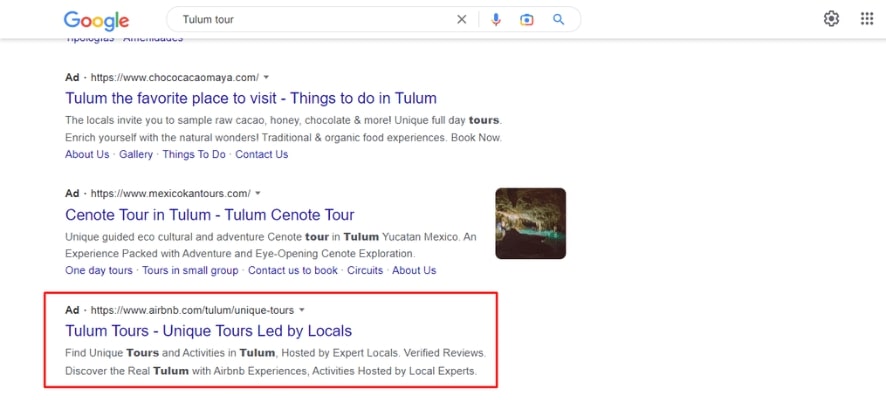
Airbnb promotes its local-led tours to those looking for outdoor activities in Tulum. In this case, Airbnb’s sponsored search ad for a local tour appears when you search for “Tulum tour.”
“Tulum Tours – Unique Tours Guided by Locals” rapidly answers the questions “where” and “how,” two details that have a powerful effect on the customer’s journey. The title’s language narrows the search for the searcher.
The description emphasizes Airbnb’s unique features — “hosted by expert locals,” “real Tulum,” and “unique tour” — persuading users to click.
It’s a terrific example of Airbnb employing a feature other than its primary accommodation services to drive traffic to its website.
Conclusion
Making online connections with travelers from around the world allows many travel companies to succeed almost completely.
However, that doesn’t mean they ignore the local visitors. Although less wide than global search advertising, Google Ads local campaigns provide great potentials that are clearly effective.
With 5 ways to optimize your Google Ads local campaigns in this article, you’re more than prepared to start attracting the interest of local tourists using Google AdWords local ads.
